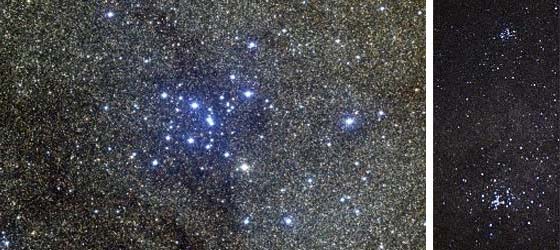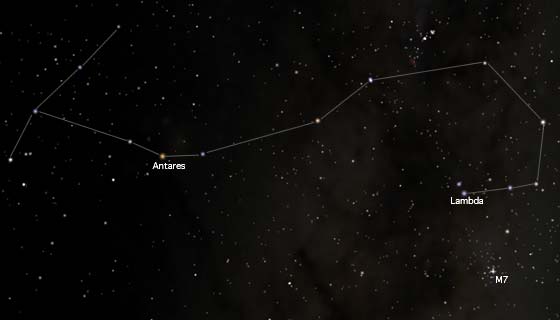
M7Here's some basic information about M7. Its an open cluster M7, type 'e', in Scorpius. It is also known as NGC 6475 or Ptolemy's Cluster (because it has been known since the time of Ptolemy, 130 AD). The position is right ascension 17h 53.9m, declination -34° 49m and the distance is 800 light years. The total visual brightness is magnitude 4.1 and the diameter is 80 arc minutes. The cluster is unusually condensed toward the center for an open cluster. There are 80 stars brighter than magnitude 10, the brightest is 5.89. Because of its size and brightness this is an easy cluster to find, even without optical aid, in fact its hard to find a telescope which will show a wide enough view to appreciate the cluster. It is probably better as a good object for binoculars. The photo on the left is by a professional observatory. On the right is a simple photo I took with a 35mm camera using 800 asa print film mounted piggy-back on a small telescope. The smaller cluster at top is M6 and M7 is the larger cluster at the bottom. 
To find M7 you need find the constellation Scorpius. This should be easy because it is one of the largest and brightest in the sky. The brightest star in Scorpius is the red supergiant Antares (apparent magnitude 1.03, the 15th brightest star in the sky). Follow the shape of Scorpius around to the bright stars in the "sting". The shape should be like a large question mark. Find the star Lambda Scorpii (magnitude 1.59) which is the last star in the scorpion shape. Go back one star to Kappa (magnitude 2.37). Look out at a right angle from these stars at a distance of about 5° you should see M7. Its big and bright so the location should be easy. Just remember in a telescope you won't see it well unless you are using really low magnification. |
![[Up]](../XuShared/Up2B.jpeg)